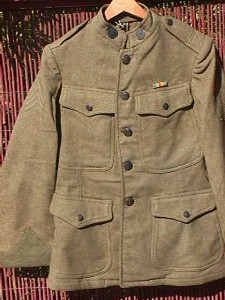
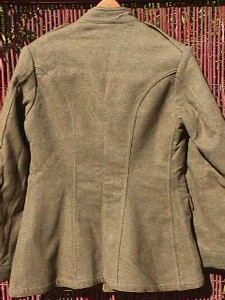
WWI USMC Summer Uniform -
The armed forces uniforms employed by the americans in WWI were constructed of heavy woolen material and usually
they were very ill fitted. The material was not water or wind resistant, making the nights and rainy days in the
front difficult to cope with. The tunic is easily distinguished by its high collar where the US and company round
emblems were worn. The pants were tight and uncomfortable to wear. The enlisted men wore spiral puttees that consisted
of a long strip of woolen fabric wound around the legs from the ankles up with a tape tucked in at the top. Many officers
opted to have their uniforms tailor made at their own expense. They would also purchase their own leather boots instead
of wearing the puttees which were difficult to put on and would come undone at the worst times.
The sample shown here is an Army uniform modified by the soldier to be a Marine Corps cuff scallop uniform. The tunic
features WWI Marine Corps blackened buttons. The uniform was manufactured in 1918. The tags in both
pieces indicate that they were manufactured in New York and issued by the Brooklyn Army depot. Both sleeves
of the tunic display Seargent stripes.
The collar discs indicate the soldier belonged to the 6th Marine Regiment, 6th Machine gun Company.
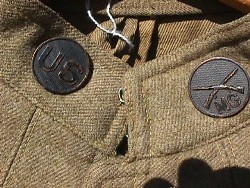
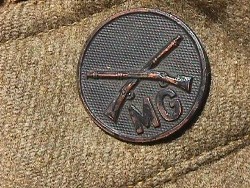
The buttons on the tunic display the marine corps eagle. The back of the buttons read "Waterbury Button Co, Conn".
They were sewn to the uniform as opposed to some models where a metal ring was employed to secure them.
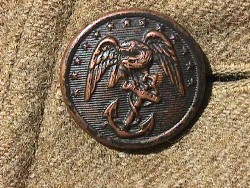
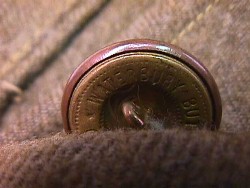
This is one of the Seargent patches that are affixed to the sleeves. On the right side is a picture of the
tag found in the tunic.
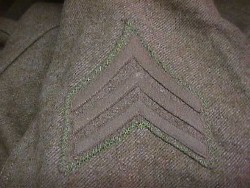
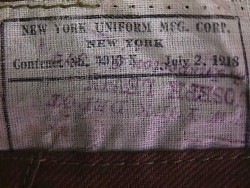
The difference in color between the pictures shown below is due to the lighting conditions. The pictures are
from the same pair of pants but on the left side the color is a little off from the rest of the uniform (more green).
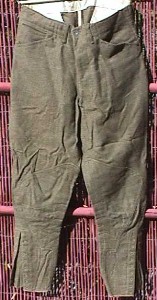
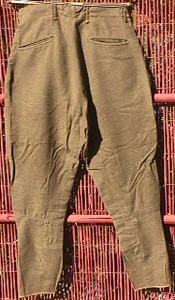
The picture on the left shows the front of the pant legs. The holes where the string was used
to secure the legs are visible. The right side picture shows the back of the same region. The string to tie the legs is
missing from this example.
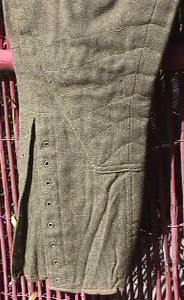
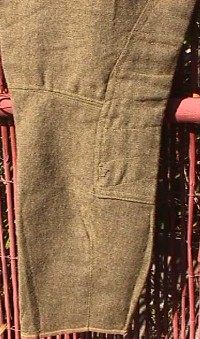
The right side of the front of the pants has a main pocket and a smaller pocket for carrying change and
other miscellaneous items. A picture of the tag found in the pants is also featured here.
|
This page is a recognition and identification guide for WWI US military uniforms.
Multiple detailed photos of a specific sample are provided. Descriptions point out
clearly defined points that should be noted.
One of the most commonly asked questions is "How much is my WWI US uniform worth?".
A price guide is included here to address this question. The value of the uniforms is
reviewed over a period of several years. A trend can be observed. The present worth
of the American military uniforms in the collector's market is illustrated.
This service is provided free of charge to the visitor/enthusiast courtesy of
MilitaryItems.com,
a company dedicated to the preservation of military history and to providing quality
military antiques and collectibles to museums, institutions and the general public.
|
|
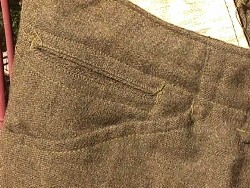

Two types of buttons are found on the pants. The main button reads "US ARMY" (left photo) while the fly
buttons read "USA" (right photo)
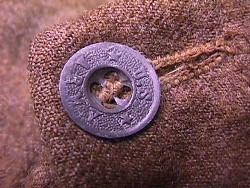
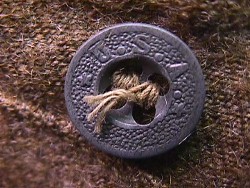
Providing an exact identification of the uniform displayed on this page has proven to be a
harder task than expected. This is due to the fact that the Marine Corps at the time went
through a shift from wearing Army uniforms to Marine uniforms. Soldiers were often left to
their own devices to complete the change by replacing buttons, collar buttons and insignia.
To compound this problem, the records maintain from the period by the armed forces are not
the most accurate. Several people have contacted me with various bits of interesting information
about the uniform. I would like to extend my thanks to the contributors and share with you,
the visitor, the information that was provided in the paragraphs that follow:
This information is provided courtesy of Mr Wayne Pettyjohn:
Owing to lack of shipping during WW I Pershing ordered that all
military serving in France were to be issued or reissued with army uniforms
once their original needed replacement. When original USMC uniforms were
replaced with army issues, marines commonly replaced the buttons with those
from their discarded USMC tunics. Marines went over with the usual forest
green tunics with no collar insignia. In the summer of 1918 FDR, during an
inspection, ordered that the enlisted men could wear an eagle, globe, and
anchor(EGA) on their collar in recognition of their valor at Belleau Wood.
This round insignia was used only during the remainder of 1918 and into
1919. Thus any original USMC tunic with these collar devices date from that
period.
With minor exceptions, marines were all in the 2nd Division, but
only their shoulder patches could be used to distinguish their particular
unit. An Indian head was attached to a white star, which in turn was
attached to one of several different shapes of material of different
colors. The background color of machine gun units was always purple.
Machine gun units in the 2nd Div included the 4th, 5th, and 6th.
The following information was provided courtesy of Mr. Kurt Johnson:
I pulled it from the out-of-print government pub,
"The United States Marine Corps in the World War," originally published in
1920. Chapter VII lists all of the battalion and company level units of
the Marine Brigade. The 6th Regiment was composed of the normal three
rifle battalions and the 73rd MG Company. The 5th Regiment had the 8th MG
Company. Then there was the separate 6th MG Battalion, of course. There
is no mention of a 6th MG Company, and I suspect that if you got this info
from the family, they may have have confused "company" with "battalion."
The 6th MG Battalion had four companies of its own (15th, 23rd, 77th, and
81st) and was a separate entity from the 5th and 6th Regiments.
This WWI US military collectible may be currently
reproduced.
It is becoming more difficult to be able to tell the fake ones from the real ones because
the quality of the reproductions is improving. The collector must become familiarized with
the construction style and materials employed in the manufacturing of this item.
Attention to the details is critical in order to be able to determine the authenticity of
the collectible.
If you have an interest is seeing other US military uniforms of WWI, you can do so by going
to our The History of the American Military Uniform
identification and price guide.
| 




